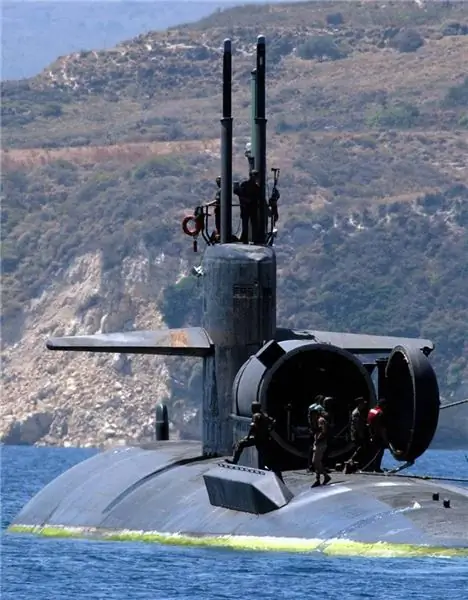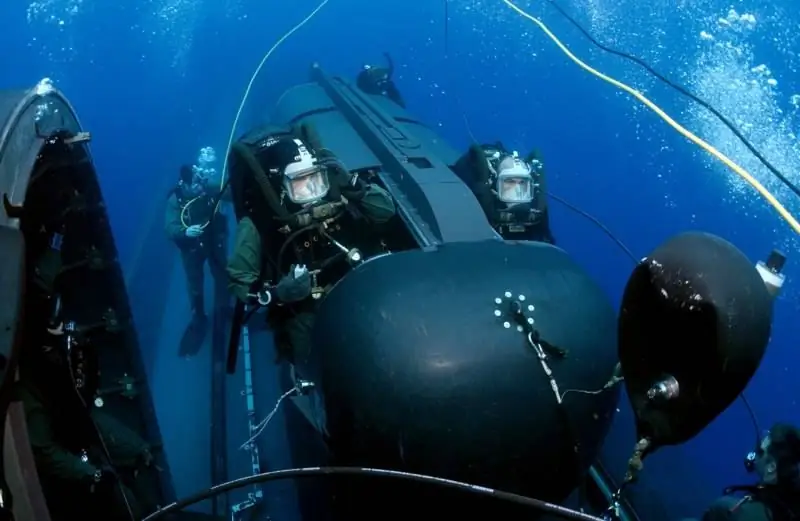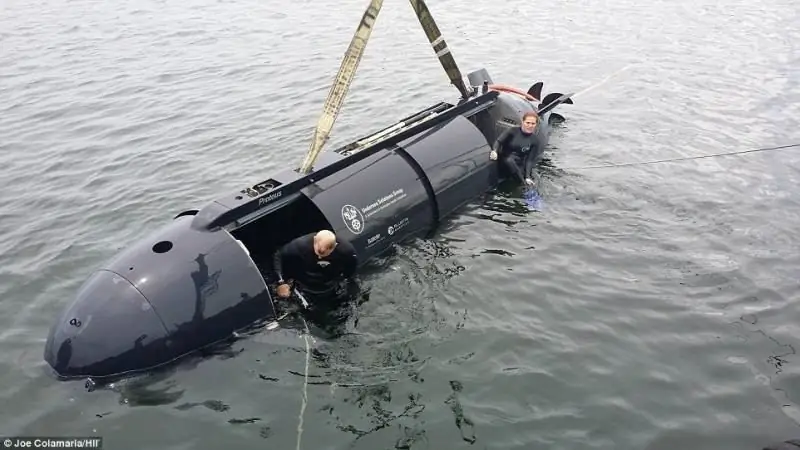- Author Matthew Elmers [email protected].
- Public 2023-12-16 21:49.
- Last modified 2025-01-24 09:17.

Human-guided torpedoes were developed during World War II for use as stealth naval weapons. On such a torpedo, two people were placed on horseback, who had the simplest navigation system and manual controls. This name was usually used for the weapons systems that Italy and later Britain deployed in the Mediterranean and used to attack ships in enemy harbors. The Japanese were also armed with a human-controlled high-speed torpedo "kaiten", which the suicide volunteer sent straight to the target in his suicidal mission. The design of these torpedoes formed the basis of the underwater delivery vehicles for combat swimmers today
During the Cold War, France was at the forefront of developing practical underwater vehicles for transporting naval special forces groups. This country developed the technology of an underwater vehicle for the delivery of combat swimmers SDV (Swimmer Delivery Vehicle), and its fleet became the first to use removable dry dock cameras DDS (Dry-Deck-Shelter). The docking camera is a container module with a hangar airlock for the exit of the combat swimmers' submarine. Swimmers' vehicles can be transported inside the docking chamber - one SDV module or up to four inflatable rubber boats. These docks were actively used by the French naval special forces Commando Hubert - the French equivalent of the US Navy SEAL (Sea, Air and Land) special forces groups. The carrier boat must be specially modified to be able to receive the DDS, it must have an appropriately configured docking hatch and appropriate electrical connections and piping for ventilation, air supply for swimmers and water drainage. In the future, with the adoption of new Suffren-class multipurpose nuclear submarines, the French Navy will regain its SDV capabilities. From the very beginning, the French nuclear submarines were designed to carry DDS behind the conning tower. They will be larger than previous dry dock cameras and will have direct access to the boat's hull so that divers can get into the dock camera even while submerged, giving a definite operational advantage.
The new SDV project for the French special forces Commando Hubert is an ESA Special Warfare Underwater Vehicle (SWUV), which will be known in the French Navy as PSM3G (Propulseur Sous-Marins de 3 Generation). ECA Group has previously supplied SDVs to the French fleet under classified contracts. Created in collaboration with the French Office of Defense Procurement, the SWUV apparatus is designed to deliver MTR and covert missions to penetrate the coast, collect intelligence data on the coast using optoelectronic subsystems and transport explosives to the target area. It will be able to deploy remote subsystems for collecting information underwater and then transmit video or tactical information via radio or satellite channel. The device has a length of 8.5 meters, compared to the previous French devices, it is larger, it can transport six combat swimmers, including two crew members.
DDS docking cameras can transport, deploy and evacuate special forces teams using inflatable rubber boats for sabotage groups CRRC or underwater vehicles SDV (SEAL Delivery Vehicle), while remaining submerged. In the era of more frequent hostilities in coastal-coastal areas, these means significantly increase the combat capabilities of both the submarine and the personnel of the special operations forces (SSO).

The SDV Mark 8 Mod 1 is currently the only SDV operated by the US Navy's Virginia and Los Angeles-class multipurpose nuclear submarines and the British Astute class submarines (for combat swimmers of the Royal Special Purpose Landing Service). This unit is an upgrade from the previous Mark 8 Mod 0. The main improvement over Mod 0 is that it is made of fiberglass reinforced plastic rather than aluminum alloy and includes a modern electronics kit.
A new SDV called Proteus is being developed by Huntington Ingalls Underwater Solutions Group, Bluefin Robotics and Battelle. Inside the "wet type" apparatus, up to six combat swimmers can be accommodated, each of them has its own air supply station. Upon reaching the target area, swimmers simply open the cargo door and swim out of the vehicle. Proteus can also be equipped with an optional air supply module installed in the center of the cargo hold, which is able to provide air to all swimmers for ten hours.
The Proteus is 8 meters long and has two vertical and two horizontal thrusters and can operate at a depth of 50 meters, moving at a speed of 10 knots. Proteus is equipped with acoustic communications for underwater data and voice communications, an Iridium satellite communications system and conventional voice and data radios. The crew can update their position data without fully ascending using a GPS receiver mounted on top of one of the masts extending above the surface of the water.
While a dry dock camera system is a practical solution for launching underwater diving transport vehicles, next generation attack submarines are designed to be able to launch and retrieve such vehicles directly from the sub's hull. One of the first such boats will be the A26 super stealth submarine of the Swedish fleet, which has ordered two submarines from the Swedish shipyard Saab Kockums.
With a resurgent Russia at its side with its free access to the Baltic Sea, the Swedish fleet decided to pay more attention to the deployment of special operations forces and, in this regard, put forward a requirement to integrate SDV systems into the project of the new A26 submarine. The A26 submarine, with its ability to lay on the ground, will become a functionally flexible platform for underwater special operations. She will not only be able to launch and return autonomous underwater and surface remotely controlled vehicles (AUV / ROV) of several types (including the new Sea Owl SUBROV, capable of conducting covert mine action, provide communications and reconnaissance) or serve as an active docking station for autonomous vehicles, but if necessary, carry out the simultaneous descent or reception of several SDV vehicles.
In the bow, the submarine will have a universal MMP (Multi-mission Portal) with a length of 6.5 meters for receiving and releasing combat swimmers, and the SDV will descend and return through an FPL (Flexible Payload Lock) airlock with a diameter of 1.6 meters, located in the bow of the boat between four torpedo tubes. The device is designed for a group of six combat swimmers and two crew members, they will be able to leave and return through the MMR, in which the device will also be stored and serviced.
The development and construction of the SDV for the A26 submarine is carried out by the joint Swedish-British group James Fisher Defense Sweden. Its tests are carried out in the archipelago near Stockholm and in the waters of the west coast of Scotland, as well as in other areas. SDVs will not only expand the range of submarines, but will also be able to perform other tasks in the coastal zone, for example, counter-terrorism operations, special operations, anti-drug operations, operations to protect offshore facilities, and mine action.

The SDV will be powered by a diesel engine, improved lithium polymer batteries, bow and stern steering motors, jet propulsion systems and rudders. Installation of engines with variable thrust vector in combination with lithium-polymer batteries made it possible to obtain a powerful apparatus with minimal acoustic signature. The SDV unit for the A26 submarine will have a range of 15 nautical miles at a speed of 5 knots. In addition to a special forces group of six people and two crew members, the apparatus has sufficient volume to accommodate a mass compensation tank, trim tanks, additional air cylinders and a cargo compartment. The vehicle will also have sealed outboard containers for equipment.
In connection with the increase in the number of operations involving submarine MTRs, defense companies are also focusing on means of dealing with SDVs and combat swimmers. Atlas Elektronik UK Ltd has developed the Cerberus Mod 2 Diver Detection Sonar (DDS), which can be installed on ships and fixed objects. The sonar itself, the cable and the operator's workstation together weigh 25 kg, which means that this portable system can be carried by one person. The sonar with its detection radius of up to 9 km provides maximum time for making a decision. Automatic detection, classification and tracking functions for underwater objects provide reliable warnings with very low false alarm rates, thus reducing operator workload.

This system is currently in service with the fleets of eight countries, and at the end of 2016 the company signed two important contracts for Cerberus Mod 2 DDS. The first contract involves the sale of several additional sonars to expand the harbor protection system. Atlas Elektronik will upload software to this system to control all hydroacoustic stations at once. The second contract was awarded to a Middle Eastern country that selected Cerberus for its very difficult conditions and also ordered certification for installation on sea vessels. In order to meet the urgent operational needs of the customer, the system was delivered within a month.
Cerberus DDS is the latest generation of swimmer detection sonar stations, specially designed for the detection and classification of divers and swimmers with closed and closed loop vehicles, manned and unmanned underwater vehicles. The military-qualified system is supplied as a lightweight, quick-deploy kit that can be operated from a ship or as part of a fixed port protection system.






